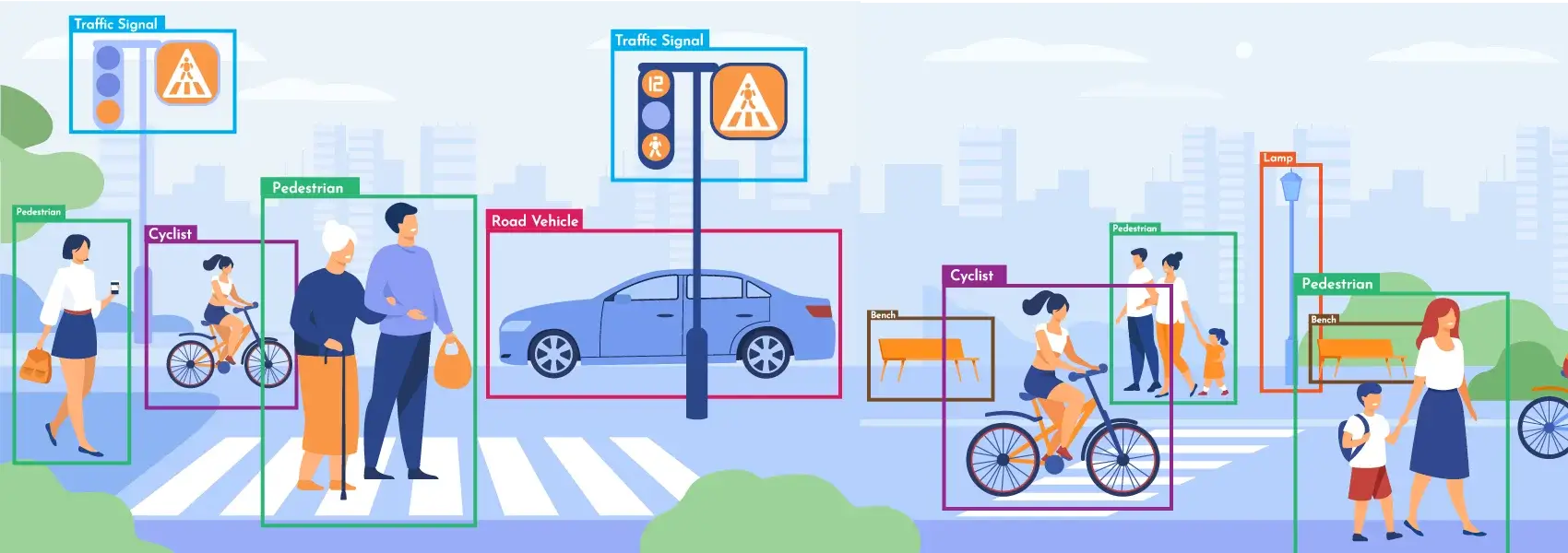Computer Vision
What is a Computer Vision?
Computer Vision is a field of Artificial Intelligence (AI) that allows systems and computers to extract significant information from digital videos, images, and other visual inputs. Just like AI allows computers to think, computer vision enables computers to observe, see, and understand.
How does Computer Vision function?
Computer Vision functions the same way as human vision except that human vision is there right from the start but computer vision needs to train machines to get this task done. Computer Vision has to perform it in a relatively way lesser time with data, cameras, and algorithms than optic nerves, retinas, and visual cortex.


Object Detection
Identify multiple objects in an image and receive information about the objects where it was found in the image Read More
Image Classification
Label your images and take control of your training data while powering your computer vision apps with large data sets Read More


Image Classification
Label your images and take control of your training data while powering your computer vision apps with large data sets Read More


Object Segmentation
The process of splitting up an object into a collection of smaller fixed-size objects in order to optimize storage and resources usage for large objects Read More
Optical character recognition
OCR services translate data into an automatic machine-editable text. OCR ensures high-quality data conversion that is faster, accurate and efficient Read More


Optical character recognition
OCR services translate data into an automatic machine-editable text. OCR ensures high-quality data conversion that is faster, accurate and efficient Read More
Object Tracking
Object tracking is the task of automatically identifying objects in a video and interpreting them as a set of trajectories with high accuracy Read More
Video Analytics
Detect and extract objects in video based on trained AI models, then classify each object to enable intelligent video analysis Read More


Video Analytics
Detect and extract objects in video based on trained AI models, then classify each object to enable intelligent video analysis Read More
Computer Vision requires lots of data. It runs scans and analyses of data again and again until it finally recognizes images. For instance, to recognize cars, a great number of car images need to be fed to identify and learn the differences between cars. This strengthens computer vision AI services to a practical front.
Algorithmic models are used by machine learning that enables a computer machine to be taught the context of visual data. When apt amount of data is fed, the computer will view data and teach itself to differentiate between images. Two vital techniques used to achieve this process are:
- A convolutional neural network (CNN)
- Deep Learning
Computer Vision Applications and Examples
As we speak, a lot of research is conducted in the computer vision field and present-day applications show how integral computer vision has become in business, transportation, entertainment, healthcare, and pretty much in everyday life. Whether it is Azure computer vision or simply AI vision, there are quite apparent roles computer vision has to play. Some examples and use of established computer vision applications:
- Object tracking
- Object detection
- Image classification
- Content-based image retrieval
Just by glancing at the terms, one could have a fair idea of these computer vision AI applications are used, be it Google Translations, IBM Solutions, self-driven cars, and so on.
Futuristech and Computer Vision
Computer Vision is a subfield of Deep Learning and Artificial Intelligence where humans teach computers to see and interpret the world around them. While humans and animals naturally solve vision as a problem from a very young age, helping machines interpret and perceive their surroundings via vision remains a largely unsolved problem.
NEED ALL PROJECT INFORMATION NOT HAVE MUCH TIME? NO PROBLEM
Our representative is always at your disposal feel free to reach out.


